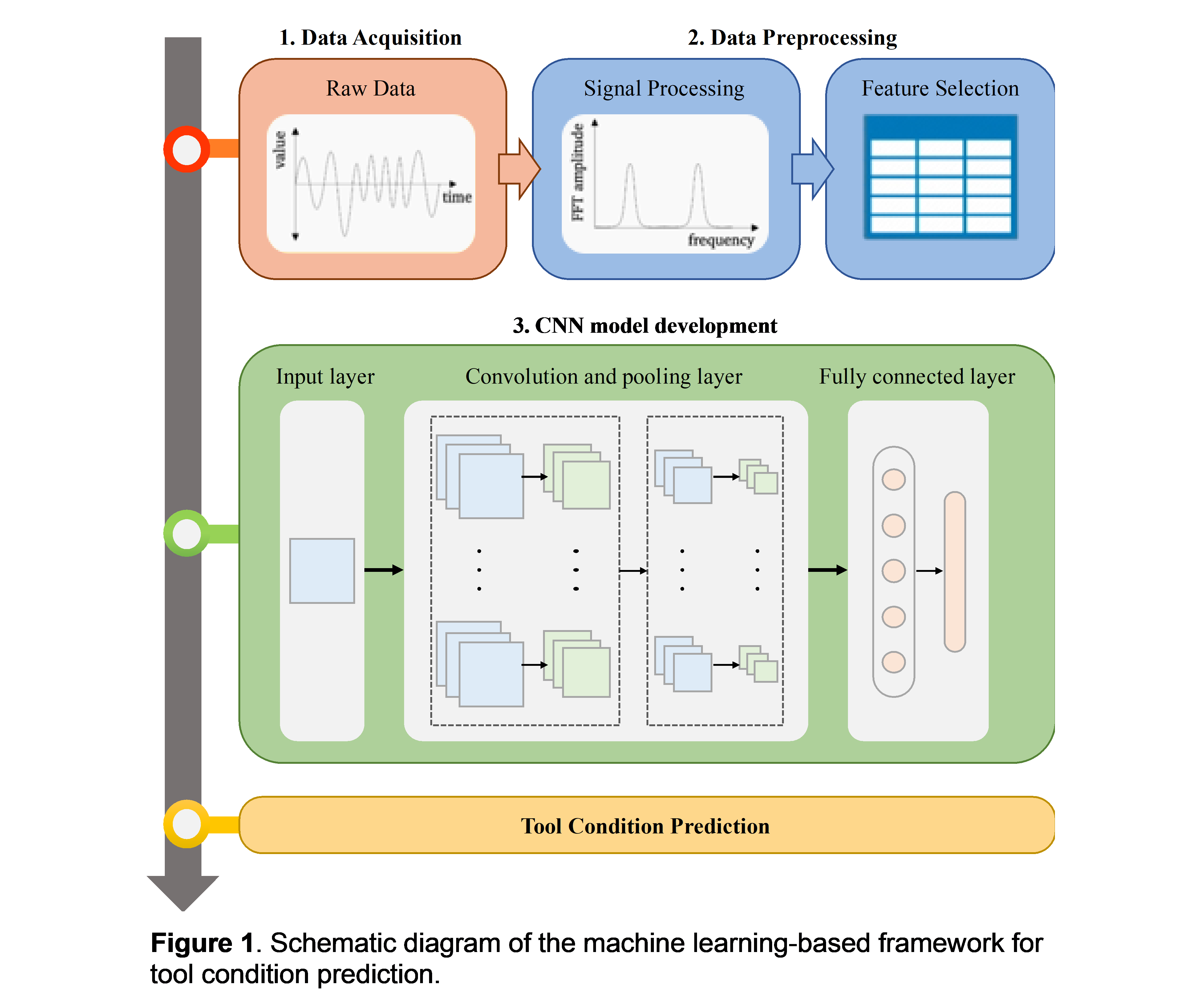2020 Virtual AIChE Annual Meeting
(108a) Machine Learning Approach for Tool Condition Monitoring in Manufacturing Systems
Authors
Modern tool condition monitoring systems leverage advances in machine learning (ML) for analysis of the state of cutting tool, classification of tool wear, or prognosis of its future state [2]. The application of ML in tool condition monitoring has been extensively studied over the past decade. Dominant methods involve ML algorithms that use techniques such as K-star algorithms [3] and Decision Trees [4]. Although these methods have shown good performance, the fundamental methodology and complete tool chain that is suitable to predict tool condition still need to be investigated. The purpose of this study is to propose an ML-based approach for predicting tool condition in CNC systems. We use convolutional neural networks (CNN) as the ML algorithm, which can provide insights into tool wear prediction in the machining process and assist with productivity improvement for the overall system.
The proposed ML-based framework in this study is presented in the Fig. 1. The method is divided into three process blocks: data acquisition, data pre-processing and CNN model development. In the data acquisition stage, we collect, tabulate and label vibration and acoustic data of the CNC process under varying cutting conditions. The vibration and acoustic data are types of the time waveforms collected at a specific time epoch for a condition. The signal pre-processing stage is necessary to extract information from the signal as features. In this step, we transform the data to the frequency domain, using Fast Fourier Transform (FFT). The data collected are time discrete and finite, thus we apply Discrete Fourier Transformation (DFT). Sometimes, it is necessary to reduce the number of features in the data, increase the information content and eliminate features of small variance to increase accuracy, reduce overfitting and computational effort. A feature selection step such as Principal Components Analysis (PCA) or Non-Linear PCA can be employed for this purpose. The selected features of audio and vibration signals are modeled and analyzed with a CNN model. The first input layer of the CNN performs operations on the features, while further layers include convolution and pooling blocks, followed by a single fully connected layer. The final layer reduces the features to map the number of tool condition classes for condition assessment. For the training of CNN, features from the signal processing stage are processed through the convolution and pooling layer for the best feature selection and then through fully connected layers to obtain prediction results. This process is repeated during the training step for given each batch size. After the final batch in training step, the model is tested with the testing dataset in testing step to generate final prediction results. This overall process is repeated for the given epoch number to optimize the model for better prediction results.
The framework of Fig. 1 was applied to two different precision machining processes. A Mazak Variaxis 630-5X II T Mill/Turn Machine 40 hp 5-axis CNC machine, representative of the type of machine in use across global manufacturing for precision machining of metals. The machine is instrumented to acquire in-process data for machine power, spindle power, spindle vibration, and to record audio/video and is MTConnect capable. The second application was on a Gerber Technology Paragon Cutter (used for fabric cutting) in which errors were injected to the real machine including a dull knife, loose knife, loose screw(s), loose swivel, no belt, worn Lanchester balancer, etc. Application of the framework of Fig. 1 for the purpose of condition monitoring and classification of the machine state will be presented. Overall classification accuracy up to 100% (counts of correct classification in the confusion matrix of the testing set) were achieved. Then, the use of the ML algorithm for the prediction of parameters of a physics-based model that accurately describes precision machining of metals will be discussed.
Acknowledgment: This material is based upon work supported by the U.S. Department of Energyâs Office of Energy Efficiency and Renewable Energy (EERE) under the Advanced Manufacturing Office Award Number DE-EE0007613.
Disclaimer: This report was prepared as an account of work sponsored by an agency of the United States Government. Neither the United States Government nor any agency thereof, nor any of their employees, makes any warranty, express or implied, or assumes any legal liability or responsibility for the accuracy, completeness, or usefulness of any information, apparatus, product, or process disclosed, or represents that its use would not infringe privately owned rights. Reference herein to any specific commercial product, process, or service by trade name, trademark, manufacturer, or otherwise does not necessarily constitute or imply its endorsement, recommendation, or favoring by the United States Government or any agency thereof. The views and opinions of authors expressed herein do not necessarily state or reflect those of the United States Government or any agency thereof.â
References
[1] D. Mourtzis, E. Vlachou, N. Milas, N. Xanthopoulos, A Cloud-based Approach for Maintenance of Machine Tools and Equipment Based on Shop-floor Monitoring, Procedia CIRP. 41 (2016) 655â660. doi:10.1016/j.procir.2015.12.069.
[2] P. Jahnke, Machine learning approaches for failure type detection and predictive maintenance, TU Darmstadt, 2015.
[3] S. Painuli, M. Elangovan, V. Sugumaran, Tool condition monitoring using K-star algorithm, Expert Syst. Appl. 41 (2014) 2638â2643. doi:10.1016/j.eswa.2013.11.005.
[4] C.K. Madhusudana, H. Kumar, S. Narendranath, Face milling tool condition monitoring using sound signal, Int. J. Syst. Assur. Eng. Manag. 8 (2017) 1643â1653. doi:10.1007/s13198-017-0637-1.
